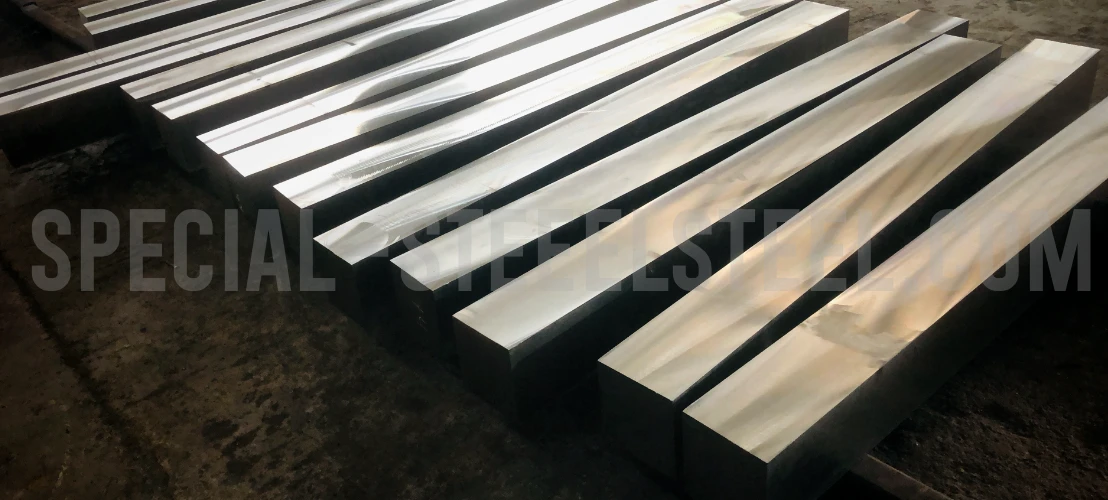
Custom 450® Stainless Steel Datasheet

Dr. Robert Anderson
Senior Materials Scientist
Custom 450® Stainless Steel Datasheet
1. Overview
Custom 450® stainless is a martensitic age-hardenable stainless steel with excellent corrosion resistance (comparable to Type 304) and moderate strength (similar to Type 410). It offers a yield strength exceeding 100 ksi (689 MPa) in the annealed condition, with good ductility and toughness after aging. The alloy is easily fabricated, weldable, and suitable for applications requiring a balance of strength and corrosion resistance.
- UNS Number: S45000
- Key Features:
- Corrosion resistance similar to Type 304 stainless.
- Three times the yield strength of Type 304.
- Easily machined, hot-worked, and cold-formed.
- Supplied in annealed condition (Condition A) for immediate use or further aging.
2. Chemical Composition
| Element | Composition (%) |
|---|---|
| Carbon | 0.05 |
| Manganese | 1.00 |
| Phosphorus | 0.030 |
| Sulfur | 0.030 |
| Silicon | 1.00 |
| Chromium | 14.00 – 16.00 |
| Nickel | 5.00 – 7.00 |
| Molybdenum | 0.50 – 1.00 |
| Copper | 1.25 – 1.75 |
| Columbium/Niobium | 0.75 |
| Iron | 72.14 – 77.14 |
3. Corrosion Resistance
Custom 450 stainless exhibits excellent corrosion resistance, particularly in atmospheric conditions, including salt water environments. It resists rusting and pitting in 5% and 20% salt spray at 95°F (35°C). Corrosion resistance is optimal in the annealed condition, with minimal degradation after aging.
Corrosion Resistance Ratings
| Environment | Rating |
|---|---|
| Nitric Acid | Good |
| Sulfuric Acid | Restricted |
| Phosphoric Acid | Restricted |
| Acetic Acid | Moderate |
| Sodium Hydroxide | Moderate |
| Salt Spray (NaCl) | Good |
| Sea Water | Restricted |
| Sour Oil/Gas | Moderate |
| Humidity | Excellent |
Typical Corrosion Rates (48-Hour Test, mpy)
| Condition | Hardness (HRC) | 20% Nitric Acid (200°F) | 5% Sulfuric Acid (75°F) | 50% Acetic Acid (Boiling) |
|---|---|---|---|---|
| A | 30 | 2 | 1 | 1 |
| H 900 | 41 | 2 | 1 | 1 |
| H 1000 | 37 | 2 | 3 | 1 |
| H 1150 | 30 | 2 | 9 | 1 |
4. Mechanical Properties
Room Temperature Properties (1" Round Bar)
| Condition | Yield Strength (ksi/MPa) | Tensile Strength (ksi/MPa) | Elongation (%) | Reduction of Area (%) | Hardness (HRC) | Charpy V-Notch (ft-lb/J) |
|---|---|---|---|---|---|---|
| A | 118 / 814 | 142 / 979 | 13 | 50 | 28 | 98 / 133 |
| H 900 | 188 / 1296 | 196 / 1351 | 14 | 56 | 42.5 | 40 / 54 |
| H 950 | 184 / 1269 | 187 / 1289 | 16 | 58 | 41.5 | 47 / 64 |
| H 1000 | 169 / 1165 | 173 / 1193 | 17 | 63 | 39 | 51 / 69 |
| H 1050 | 152 / 1048 | 160 / 1103 | 20 | 66 | 37 | 69 / 94 |
| H 1150 | 92 / 634 | 142 / 979 | 23 | 69 | 28 | 97 / 132 |
Elevated and Cryogenic Temperatures
Custom 450 maintains good mechanical properties across a wide temperature range, from -320°F (-196°C) to 1050°F (566°C). Detailed properties are available for specific conditions (e.g., H 900, H 1050) at various temperatures.
5. Physical Properties
- Specific Gravity: 7.75 (Condition A), 7.76 (H 900)
- Density: 0.2800 lb/in³
- Thermal Conductivity (H 900, Btu-in/ft²·h·°F):
- 73°F: 104
- 932°F: 169
- Mean Coefficient of Thermal Expansion (75°F to 1100°F, Condition A): 5.68 – 6.17 x 10⁻⁶ in/in/°F
- Modulus of Elasticity: 28.0 x 10³ ksi (Condition A), 29.0 x 10³ ksi (H 900)
- Poisson’s Ratio: 0.290 (H 900)
6. Heat Treatment
- Solution Treatment (Condition A):
- Heat to 1875–1925°F (1024–1052°C), hold for 1 hour, rapid cool (water or oil quench preferred).
- Aging (H 900, H 950, H 1000, H 1050, H 1150):
- Age at 900–1150°F (482–621°C) for 4 hours, air cool.
- H 900 offers the best strength-ductility-toughness balance.
7. Workability
- Hot Working: 1650–2300°F (900–1260°C), optimal at 2100–2150°F (1150–1177°C).
- Cold Working: Low work-hardening rate allows significant cold reduction without intermediate annealing.
- Machinability: Comparable to other martensitic stainless steels; use conservative speeds and feeds (see detailed tables in original document).
8. Welding and Brazing
- Welding: Easily welded, but solution annealing post-welding is recommended for optimal properties.
- Brazing: Use brazing materials suitable for Type 304, with temperatures aligned with annealing range.
9. Descaling and Cleaning
- Descaling: Acid cleaning (muriatic acid at 180°F, followed by nitric-hydrofluoric acid mix) or grit blasting.
- Heat Tint Removal: Polish, vapor blast, or pickle in nitric-hydrofluoric acid solution.
10. Applications
Custom 450 is ideal for applications requiring high strength and corrosion resistance, such as:
- Aerospace components
- Oil and gas equipment (sour service per NACE MR-01-75)
- Chemical processing equipment
- Marine environments